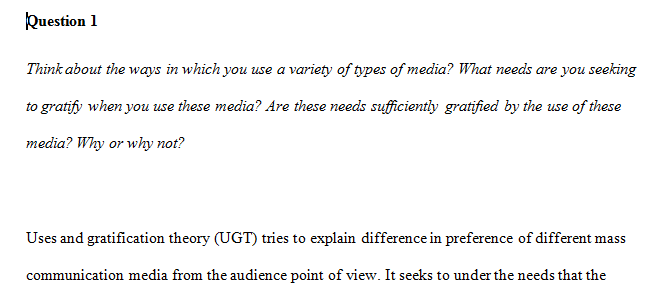Uses & Gratifications
| Style | APA |
| Number of words | 812 |
| Number of sources | 0 |
| Spacing | Double |
| PowerPoint slides | 0 |
I’m trying to learn for my Communications class and I’m stuck. Can you help?
Think about the ways in which you use a variety of types of media? What needs are you seeking to gratify when you use these media? Are these needs sufficiently gratified by the use of these media? Why or why not?
In what ways can a deep understanding of uses and gratifications theory benefit the work of public relations practitioners?
McQuail, D. (1994). The rise of media in mass communication. In D. McQuail (Ed.), Mass Communication Theory:
An Introduction (pp. 1–29). London: Sage. This introductory chapter to McQuail’s textbook on mass communication theory outlines several foundational concepts—including uses and gratifications theory—related to the role of the media in mass communication.
Ruggiero, T.E. (2000). Uses and gratifications theory in the 21st century. Mass Communication & Society, 3(1), 3-37. In response to claims that uses and gratifications theory loses its utility in computer-mediated contexts, this article seeks to defend the utility and legitimacy of the theory. The author also identifies areas for future research in digital media leveraging UGT.
Tustin, N. (2010). The role of patient satisfaction in online health information seeking. Journal of Health Communication, 15, 3-17. Using the author’s study of 178 cancer listserv users, this research examines the impact of the use of the internet to find health information on cancer survivors’ satisfaction with their care.
Rathnayake, C. & Winter, J.S. (2018). Carrying forward the uses and grats 2.0 agenda: An affordance-driven measure of social media uses and gratifications. Journal of Broadcasting & Electronic Media, 62(3), 371-389. Recent research about uses and gratifications in social media has focused on affordances—the mutuality between users’ needs and platforms’ features. This study seeks to establish four different types of affordances to enhance our understanding of how uses and gratifications theory illuminates social media communication.

